Inventory Collaborative 2016v1 Emissions Modeling Platform
Back to Collaborative Wiki Main Page
Overview
The 2016 beta platform has been developed by the National Emissions Collaborative. Updates will be made to this platform prior to the release of the "2016 Version 1.0" platform.Release Timeline
- March 13, 2019: 2016 base year data, software, and scripts
- TBD: Future year projection year data
Download
Disclaimer: The 2016beta emissions inventories and ancillary data are draft data. The Collaborative intends to use the 2016beta platform to evaluate the emissions data and air quality modeling results derived from these data towards the development of a 2016 version 1 emissions modeling platform. Users of these data acknowledge that they are distributed as is, and that they have not been extensively evaluated by the Collaborative.
The initial release of the 2016beta platform is for the year 2016 only. Click here to download it from the Intermountain West Data Warehouse.
If you do not need a full modeling platform and are instead interested in only a subportion of the inventories or ancillary data, or in summary reports for specific sectors, you can find data of that nature at ftp://newftp.epa.gov/air/emismod/2016/beta/
Report Issues/Feedback
We encourage users of the 2016beta emissions data to provide feedback to the Collaborative on any issues or concerns discovered in these data. The Collaborative will consider the feedback that we receive on the 2016beta emissions in the development of the version 1 emissions modeling platform.
Questions and problems with the data, and problems with the software in the platform release package are examples of the types of issues to post to the forum. The Collaborative workgroup co-leads will review the reported issues and consider updates to the platform for the release of 2016v1.
May 31, 2019 is the deadline for comments on the 2016beta platform. Comments received before this date will be considered for inclusion in the 2016v1 emissions platform.
Instructions for submitting a comment topic:
- Go to the CMAS Center forum
- Click New Topic in the upper right corner of the page
- Type in the topic subject (like an email subject)
- Click on 'Uncategorized' and search for *2016* to find the NEI Modeling platform and Collaborative Modeling Platform 2016 categories
- Type in the body of your topic (like the body of an email)
- Click Create Topic to finish the process
Description
In late 2017, a group of state, local, tribal, regional, and federal air planning agencies initiated a collaborative process to build a national emissions modeling platform (EMP) for simulating air quality in the U.S. The 2016beta EMP is the first product from the National Emissions Inventory Collaborative that includes a full suite of base year (2016) and future year inventories, ancillary emissions data, and scripts and software for preparing the emissions for air quality modeling.A coordination workgroup, ten sector workgroups, and a modeling workgroup were staffed by over 245 state and regional air agency, EPA, and Federal Land Manager employees. The work of the sector workgroups to build 2016 base year and future year inventories is documented in a series of sector-specific specification sheets below. These specification sheets detail the origin of the inventories and ancillary data used to simulate criteria pollutant, and in many cases hazardous air pollutant, emissions for the U.S., Canada, and Mexico.
The summary stacked bar plots below compare U.S. total criteria pollutant emissions for the 2016beta platform back to 2011 and 2014 base and future year emissions.
Documentation
The documentation is available as a separate document for each modeling sector:
- Mobile - Onroad
- Mobile - Nonroad
- Mobile - Nonroad - C1/C2 Commercial Marine Vessels
- Mobile - Nonroad - C3 Commercial Marine Vessels
- Mobile - Nonroad - Rail
- Point - EGU - ERTAC
- Point - EGU - IPM
- Point - non-IPM
- Point - Fires - Agricultural
- Point - Fires - Wild and Prescribed
- Canada - Mobile - Onroad
- Mexico - Mobile - Onroad
- Canada/Mexico - Point
- Canada/Mexico - Point - Fires
- Canada/Mexico - Nonpoint
- Canada - Nonpoint - Area Fugitive Dust
- Canada - Point - Dust
- Canadian Inventory Documentation
Summary of Platform Comments
The Collaborative workgroups reviewed comments received from the community on the beta platform. Where feasible, the feedback received on the beta platform was integrated into the V1 inventories.
View the List of 2016beta Platform Comments by sector
Summary Data and Plots
Descriptions of the emissions platform cases in the summary data and plots are as follows:
- 2011en, 2023en, 2028el = Final 2011, 2023, and 2028 cases from the 2011v6.3 platform
- 2014fd = NEI2014v2 and 2014 NATA
- 2016ff = 2016beta platform
Download Excel summary spreadsheet of annual total emissions by state-county-sector.
The spreadsheet includes emissions data for the 2016beta, 2014v2, and 2011v6.3 platforms
CO
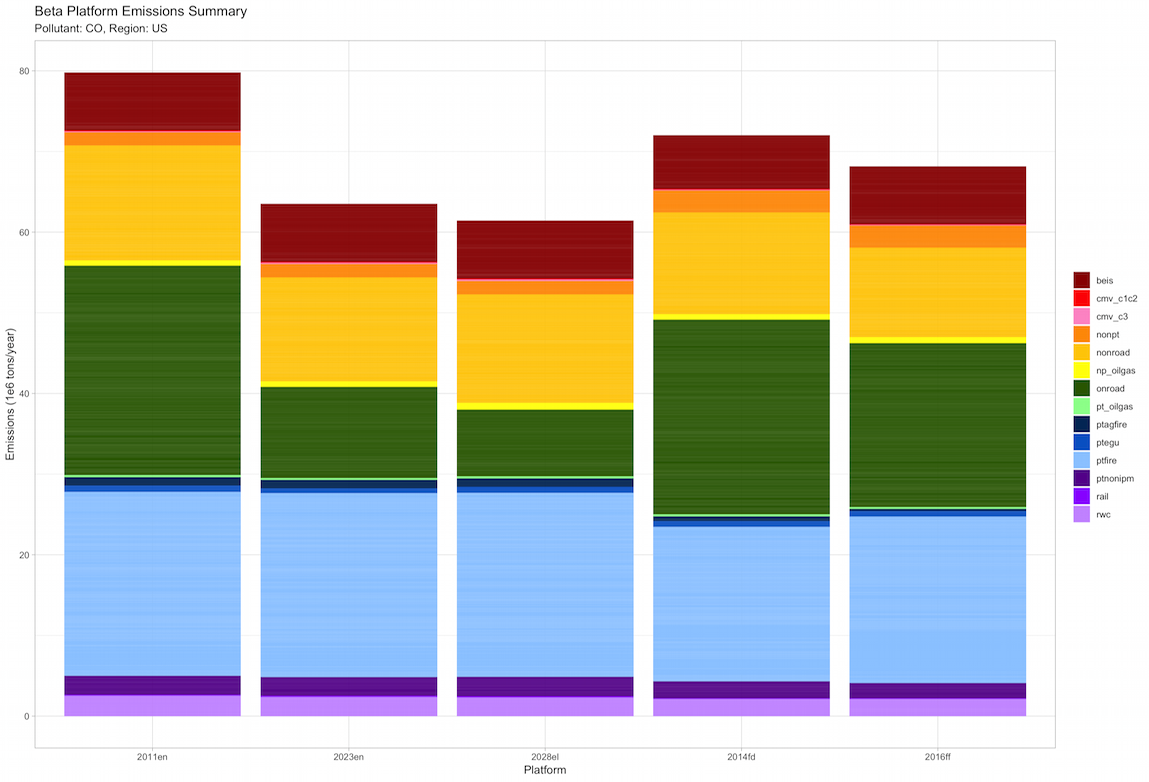
NOx

VOC
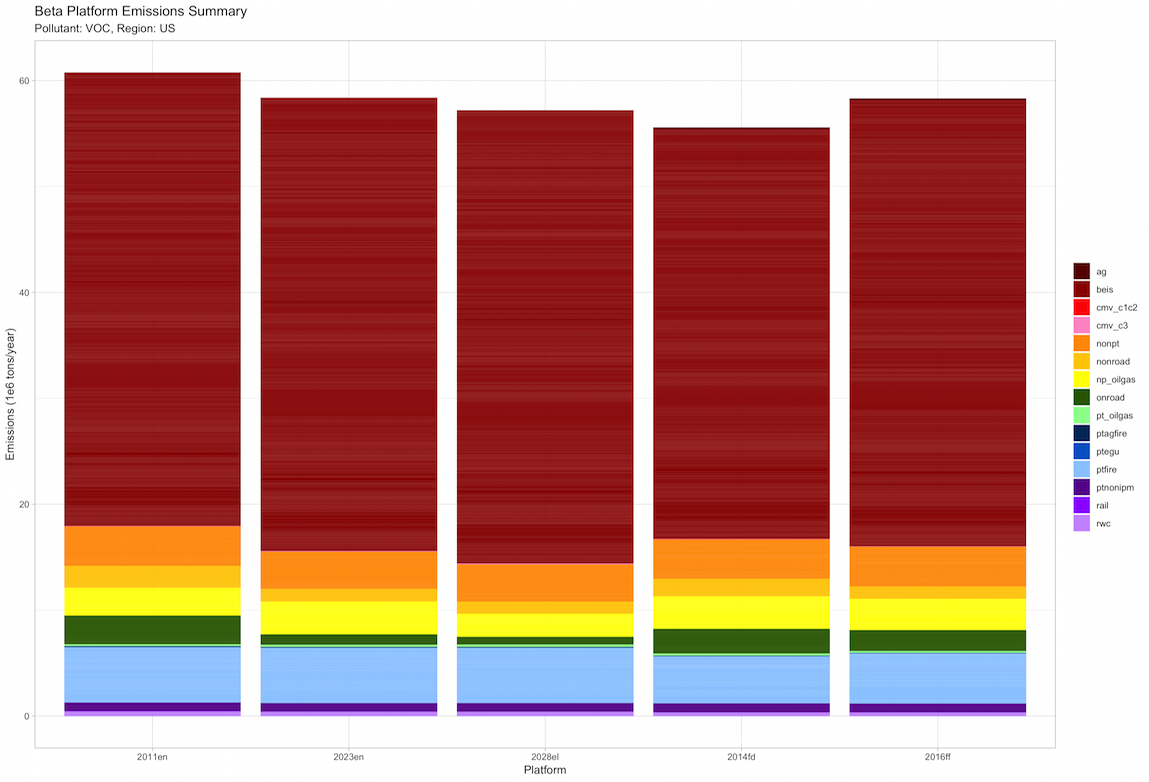
NH3
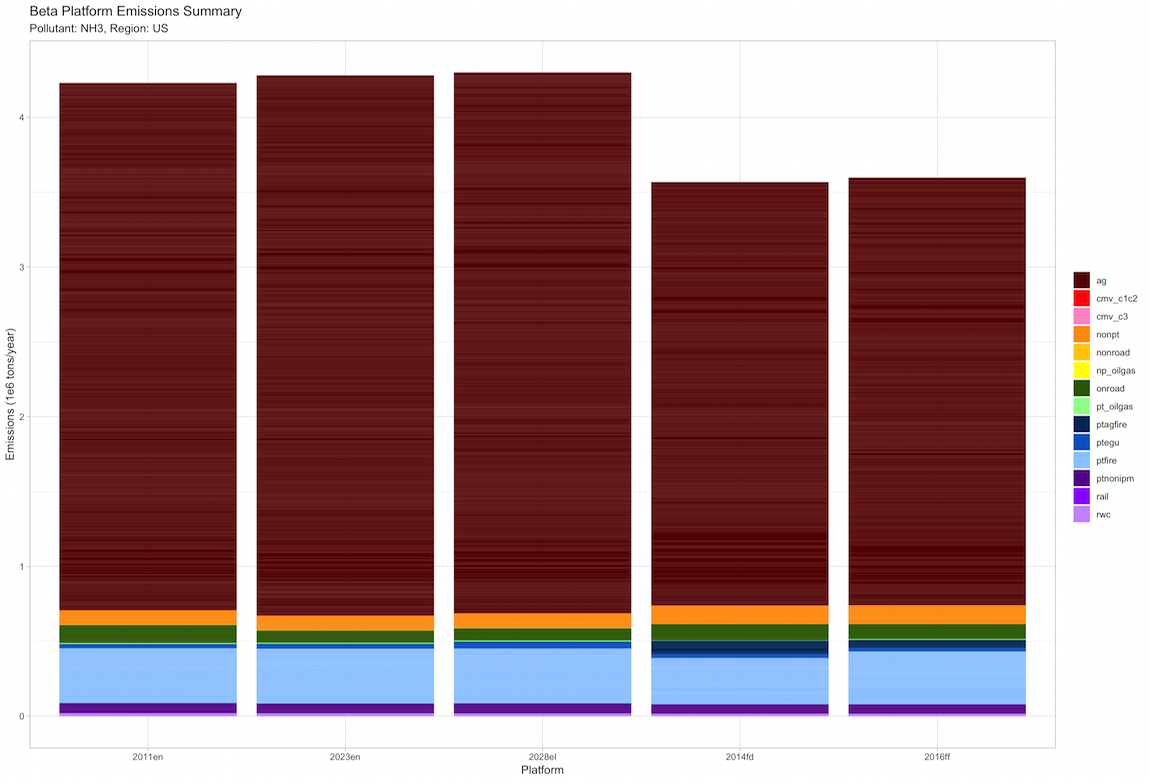
SO2
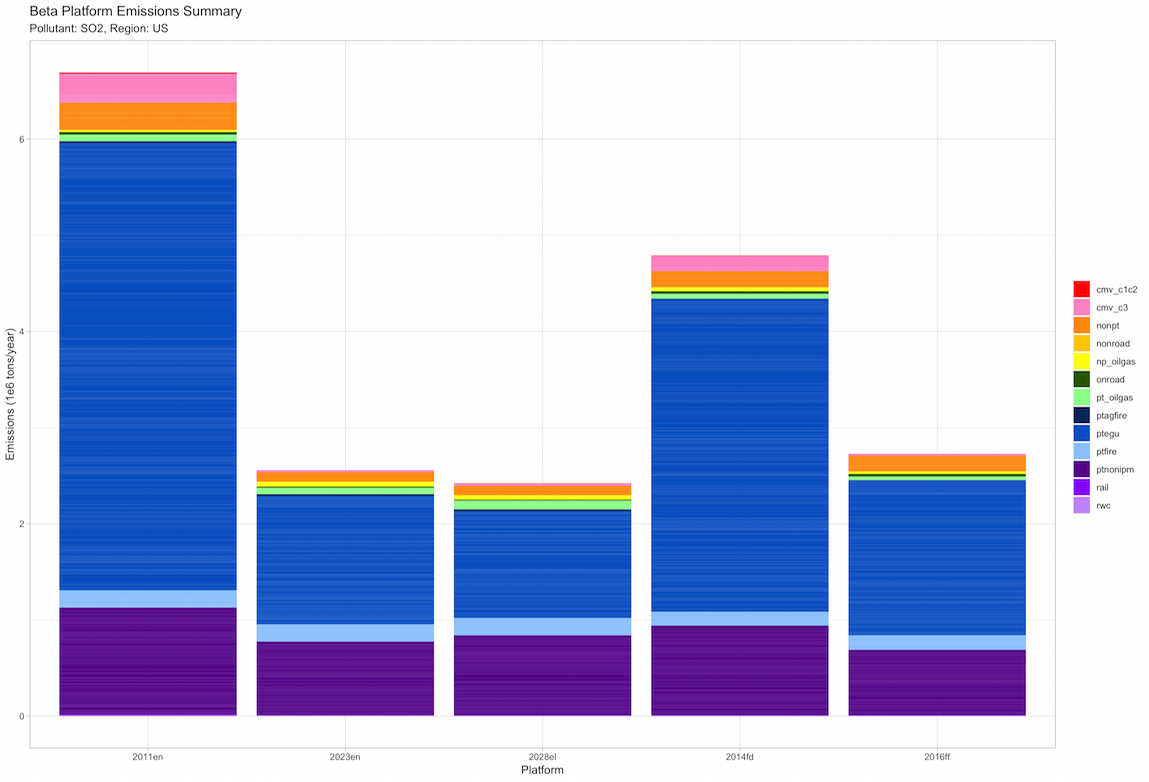
PM2.5
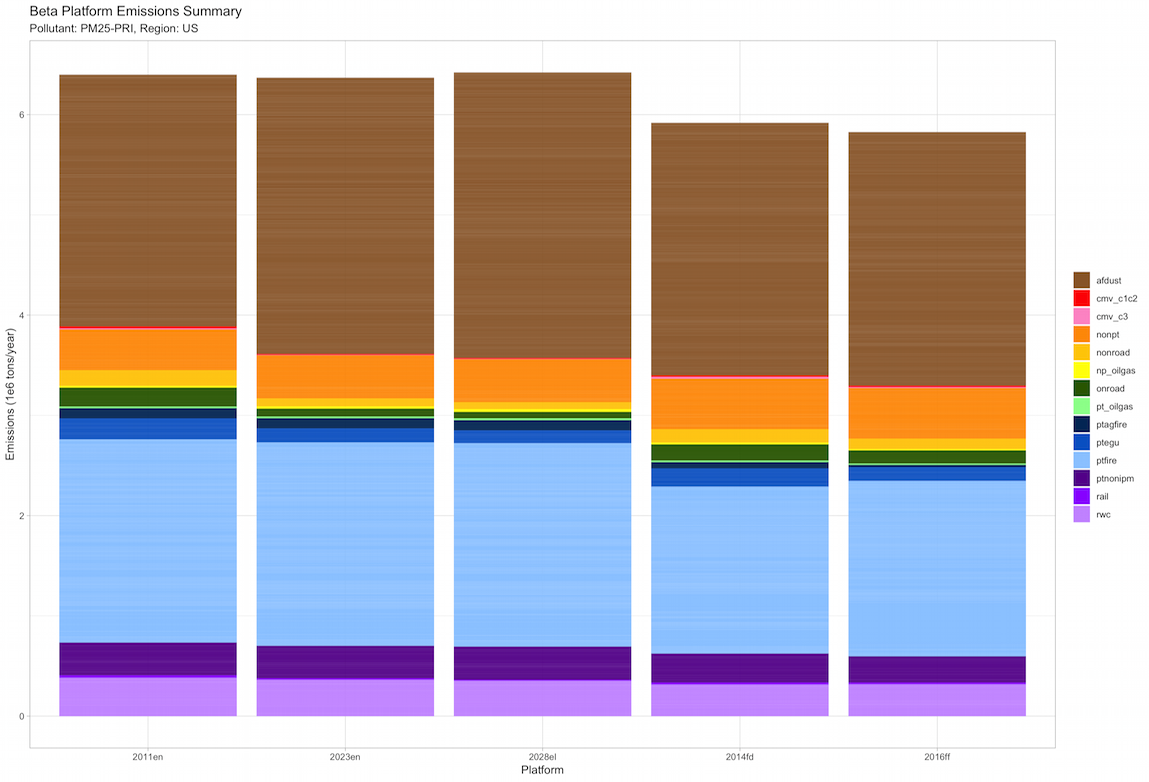
Additional Analysis Products
Access 2016beta platform emissions summaries, including comparisons to previous (2011 and 2014) emissions modeling platforms and future year inventory projections.LADCO Plot Viewer
Pre-generated, graphical emissions summaries including bar charts, thematic maps, and gridded maps
IWDW Emissions Review Tool
Interactive website with capabilities to generate customized bar charts and maps of the 2016beta and future year emissions
Collaborative 2016beta Google Drive
Folders by inventory sectors with zip files of tabulated SMOKE report emissions report files. See the zip file tagged "annual_reports" in each sector directory.
How to Cite
2016beta platformNational Emissions Inventory Collaborative (2019). 2016beta Emissions Modeling Platform. Retrieved from http://views.cira.colostate.edu/wiki/wiki/10197.
Specification sheets (e.g., onroad mobile)
National Emissions Inventory Collaborative (2019). Specification Sheet - 2016beta Platform Onroad Mobile Emissions. Retrieved from http://views.cira.colostate.edu/wiki/Attachments/Inventory%20Collaborative/Documentation/2016beta/National-Emissions-Collaborative_2016beta_mobile-onroad_28Feb2019.pdf.
Acknowledgements
Assembling, evaluating, and documenting the initial release of the 2016beta platform involved over 245 committed air quality scientists across multiple state, local, tribal, and regional agencies, and EPA and Federal Land Management agencies. Several consultants and industry employees contributed to the workgroups through participating in conference calls and presenting on important inventory developments that were relevant to the Collaborative.Particular acknowledgement of the workgroup co-leads is due, as they worked to recruit, organize, and lead their workgroups through the Collaborative platform development and documentation process.
Refer to the Collaborative inventory workgroup wikis for complete lists of the workgroup co-leads and participants.